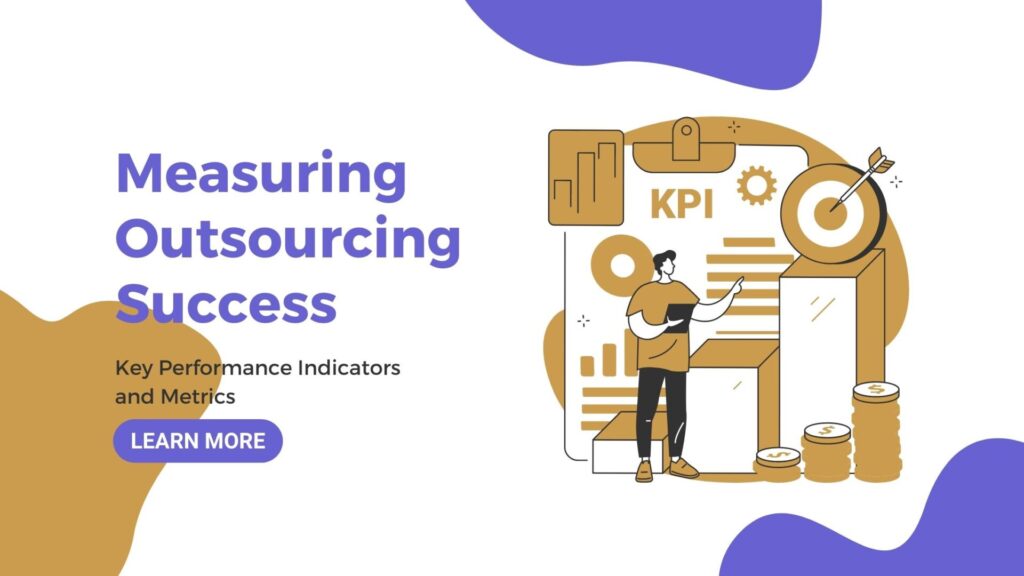Outsourcing certain processes, operations, or tasks to external partners or service providers allows businesses to obtain access to specialised expertise while remaining focused on their core competencies.
While it can provide significant benefits to a business, precisely monitoring its success is critical to ensuring that the desired goals are met. Measuring outsourcing performance provides useful insights into how outsourcing affects many parts of business operations. It enables organisations to assess if the outsourcing arrangement coincides with their strategic goals and delivers the promised return on investment (ROI).
Outsourcing has gained widespread adoption as a strategic approach, empowering organisations to tap into specialised expertise, lower expenses, and boost operational effectiveness. However, measuring the success of outsourcing initiatives is crucial to ensure that the expected benefits are realised. By establishing appropriate Key Performance Indicators (KPIs) and metrics, businesses can effectively evaluate and quantify the impact of outsourcing on their operations. In this article, we explore the essential KPIs and metrics for measuring outsourcing success and guide you on the best practices to implement for accurate evaluation.
Understanding Outsourcing Success
Outsourcing success encompasses various factors beyond cost savings alone. It involves achieving operational excellence, maintaining service quality, enhancing customer satisfaction, and driving overall business growth. To accurately measure outsourcing success, organisations need to consider a combination of KPIs and metrics that align with their specific objectives and priorities. Delve into this article and gain insight on 10 key strategies to successful outsourcing.
Key Performance Indicators (KPIs) for Outsourcing Success
Cost Savings and Return on Investment (ROI)
One of the primary reasons businesses opt for outsourcing is to achieve cost savings and improved ROI. KPIs related to cost reduction and financial gains help gauge whether outsourcing initiatives are delivering the expected economic benefits.
Quality and Service Level Agreement (SLA) Adherence
Assessing the quality of outsourced services and the extent to which service level agreements (SLAs) are met is crucial for maintaining service excellence and meeting customer expectations.
Efficiency and Time Savings
Efficiency and time savings are pivotal factors in any business environment. In the context of outsourcing, they play an even more significant role, as the primary goal of outsourcing is often to enhance operational effectiveness and streamline processes. When tasks are outsourced to external service providers, organisations anticipate efficiency gains that can lead to faster task completion and resource optimization.
Customer Satisfaction and Retention
Measuring customer satisfaction levels allows organisations to evaluate the impact of outsourcing on customer experiences and retention rates. By understanding how customers perceive and respond to outsourced services, companies can make informed decisions to enhance service delivery, build stronger customer relationships, and ultimately achieve higher retention rates.
Employee Satisfaction and Productivity
It is crucial for businesses to recognize the human aspect of outsourcing and assess how it affects the well-being and morale of their internal teams. Addressing employee concerns and feedback is key to ensuring that the outsourcing initiative is beneficial for both the organisation and its workforce. Businesses should act on feedback and make positive changes when required.
Metrics for Measuring Outsourcing Success

Cost Savings Percentage
Cost savings in outsourcing refer to the reduction in expenses that businesses experience by delegating certain functions or processes to external service providers. Accurate cost savings calculation is crucial for organisations to gauge the true impact of outsourcing on their financial performance. It enables businesses to make data-driven decisions, justify the effectiveness of outsourcing initiatives to stakeholders, and identify areas for further cost optimization.
Defect Rate or Error Reduction
Defects and errors in outsourcing refer to any deviations or inaccuracies that occur during the execution of outsourced tasks or processes. These can range from minor mistakes to more significant discrepancies that impact the quality and delivery of services. By identifying and addressing these issues, organisations can make data-driven decisions and implement targeted strategies to enhance overall performance.
Turnaround Time or Cycle Time
Outsourcing has the potential to yield efficiency gains for businesses if they can measure the time taken to complete outsourced tasks. By employing time tracking tools, defining milestones, and analysing efficiency metrics, organisations can make informed decisions to optimise outsourcing strategies and drive sustainable growth.
Net Promoter Score (NPS)
NPS is a metric used to measure customer loyalty and gauge how likely customers are to recommend a company's products or services to others. It is based on a simple question: "On a scale of 0 to 10, how likely are you to recommend our services to a friend or colleague?".
NPS plays a crucial role in understanding the overall satisfaction level of customers who interact with outsourced services or support. It helps businesses identify strengths and weaknesses in their outsourcing partnerships, allowing them to make data-driven decisions to improve customer experiences and boost loyalty.
Employee Engagement Score
Employee engagement refers to the emotional commitment and enthusiasm employees have towards their work and the organisation. It is an important factor in determining employee productivity, loyalty, and overall job satisfaction. When businesses engage in outsourcing, it can introduce changes in the work dynamics and may impact employee engagement levels. Assessing employee engagement helps identify potential challenges and allows businesses to take proactive measures to support and motivate their workforce.
Best Practices for Effective Measurement
In order for an organisation to ensure that it is accurately measuring outsourcing success, the following best practices should be followed:
Align KPIs and Metrics with Business Objectives
These quantifiable measures help businesses monitor various aspects of their operations, from financial performance and customer satisfaction to employee productivity and more. However, for KPIs and metrics to be truly effective, they must be carefully defined and aligned with the organisation's strategic goals. Aligning KPIs and metrics with organisational goals is critical for ensuring that every aspect of a company's performance contributes to its overall strategic direction. When KPIs are strategically aligned, they act as guideposts, providing clear direction and focus to all stakeholders on what matters most to the organisation's success.
Establish Baselines and Targets
By setting baseline values, businesses gain clarity on their current performance levels. This understanding enables leaders to recognize strengths and weaknesses and guides them in assessing growth and identifying areas requiring attention.
Regular Monitoring and Reporting
By setting baseline values, businesses gain clarity on their current performance levels. This understanding enables leaders to recognize strengths and weaknesses and guides them in assessing growth and identifying areas requiring attention.
Continuous Improvement and Adaptation
To stay on track and ensure meaningful measurement, businesses should regularly review and refine the chosen KPIs and metrics. Selecting the right KPIs and metrics is a foundational step in performance measurement. The choice of measures should directly align with the organisation's strategic goals and reflect its core values. By focusing on relevant KPIs, businesses can ensure that their efforts are channelled towards achieving meaningful outcomes.
Conclusion
Measuring outsourcing success is crucial for businesses to evaluate the impact of outsourcing initiatives and ensure alignment with organisational goals. By establishing relevant KPIs and metrics, organisations can gain insights into cost savings, service quality, efficiency, customer satisfaction, and employee productivity. Implementing best practices in measurement allows businesses to make informed decisions, optimise outsourcing strategies, and drive sustainable growth.
Frequently Asked Questions (FAQs)
A: Calculating the Return on Investment (ROI) of outsourcing involves comparing the total costs associated with outsourcing to the benefits gained. A positive ROI percentage indicates that the outsourcing initiative has been financially beneficial for the business. Conversely, a negative ROI suggests that the costs outweigh the benefits, and the outsourcing arrangement may need reevaluation.
A: Common Service Level Agreements (SLAs) in outsourcing agreements include metrics related to response times, task completion, quality standards, and availability of services. For example, SLAs may define that certain tasks should be completed within a specified timeframe or that customer support inquiries must receive a response within a certain number of hours.
A: It can impact employee morale and productivity in different ways. By relieving employees of repetitive tasks, it will enable them to focus on strategic and value-added activities, thus boosting their morale. Outsourcing, however, can trigger apprehensions about job security, potentially affecting morale negatively. Therefore, fostering clear communication and employing strategic workforce planning are vital to minimise any detrimental consequences on employee morale and productivity.
A: In addition to traditional KPIs and metrics, businesses can consider metrics related to innovation and the ability to adapt to changing market conditions. These additional metrics provide a more comprehensive view of the overall impact of outsourcing on various aspects of the business.
A: KPIs and metrics should be reviewed and updated regularly, ideally at least quarterly or annually. However, the frequency may vary based on the specific business needs and the pace of industry changes. Regular reviews ensure that KPIs remain relevant, aligned with business objectives, and reflective of the current business environment.
For businesses to reap the full benefits of outsourcing, it is crucial to measure its success and evaluate its impact on various aspects of the organisation. Taskforce Outsourcing will help you navigate the path to informed decisions and strategic success, which lies in leveraging insights from measurement and embracing continuous improvement in the ever-evolving business landscape.


